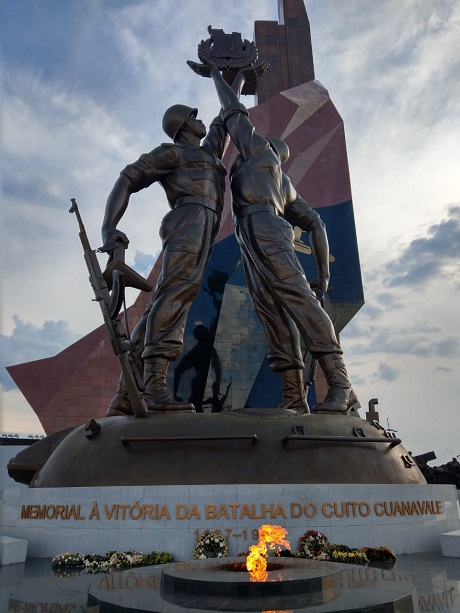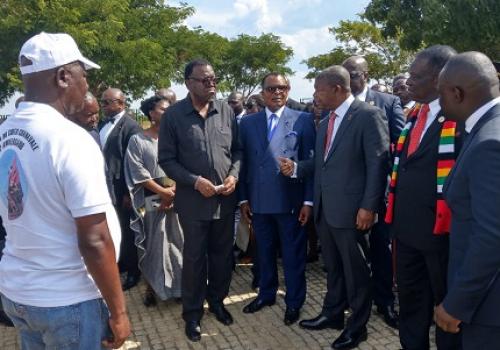Cuito-Cuanavele, Angola: Thirty One (31) years ago, the small town of Cuito Cuanavale of approximately 95,000 inhabitants and 35,610 square kilometres, in the Province of Cuando Cubango, southern part of Angola, was the epicenter of one the fiercest conventional battles of the African history, after the second World War. From November 1987 to March 1988, thousands of combatants from the Peoples Liberation Armed Forces (FAPLA) supported by the Peoples Liberation Army of Namibia (PLAN) and the Cuban Revolutionary Forces waged a war and defeated the mighty armed forces of the Apartheid regime of South Africa.
For the first time, following the endorsement of the SADC Summit of Heads of State and Government in August 2018, on 23rd March, 2019, leaders from the SADC region gathered in Cuando Cubango Province to commemorate the Southern Africa Liberation Day which is dedicated to the Cuito Cuanavale battle.
Present at this historic event were the Heads of State from Angola, Namibia, Zimbabwe, Congo-Brazzaville and Democratic Republic of Congo (DRC); representatives from Botswana, Comoros, Eswatini, Mozambique, South Africa and Seychelles as well as the Vice-President of the Republic of Cuba and representatives from the Russian Federation (Former Soviet Union).
In his remarks, His Excellency João Lourenço, President of the Republic of Angola underscored the importance of remembering the Cuito-Cuanavele battle. “This location where we are gathered today signifies the defeat of the racist army of South Africa which opened the doors for the independence of Namibia and the liberation of Nelson Mandela and consequently, marked the end of the Apartheid in South Africa”.
H.E. President João Lourenço thanked the SADC leaders for their decision to adopt the 23 March as the Southern Africa Liberation Day and stressed that; “the Republic of Angola is proud for this historic decision which enables the present and future generations of the southern African region to remember the countries and people who played part in liberation struggle so that their sacrifices are not forgotten”.
Speaking at the same event, President of the Republic of Namibia and Chairperson of SADC, His Excellency Dr. Hage G. Geingob paid tribute to the heroes and heroines who made sacrifices for the liberation of southern African states indicating that SADC Nations are enhancing regional integration because of the blood that was shed to pave the way for the independence and freedom of our region.
“We now owe it to our heroes and heroines to make sustainable development and prosperity for our people, a reality,” said H.E. President Dr. Geingob.
The SADC Chairperson recognised the role played by the former Union of Soviet Socialist Republics (USSR, Currently the Russian Federation), Cuba, the Frontline States, as well as Nigeria and the Scandinavian countries for the political, military and material support rendered in the liberation struggle and added that the Battle of Cuito Cuanavale “was the battle to end all the battles” forcing the Apartheid regime and their allies to accept a negotiated solution based on the United Nations Security Council Resolution (UNSCR) 435/78 subsequently leading to the independence of Namibia.
At the end of the event, the leaders of the region condecorated 51 combatants and veterans from Angola, Cuba, Russian Federation and Namibia who fought in the Cuito Cuanavale battle.
Chronology of events[1]:
- 23rd March 1988: End of the Cuito Cuanavale Battle;
- 22nd December 1988: Signing of the New York Agreement. A tripartite agreement between Angola, Cuba and South Africa on the implementation of the UNSCR 435/78 and the removal of the Cuban revolutionary forces from Angola;
- 1st April 1989: Initiation of the implementation of the UNSCR 435/78 leading to the independence of Namibia;
- 11th February 1990: Release of Nelson Mandela from prison;
- 21st March 1990: Independence of Namibia.
[1] For more details consult the Hashim Mbita Research Project on the history of the Southern Africa Liberation available at the SADC Secretariat Library.


